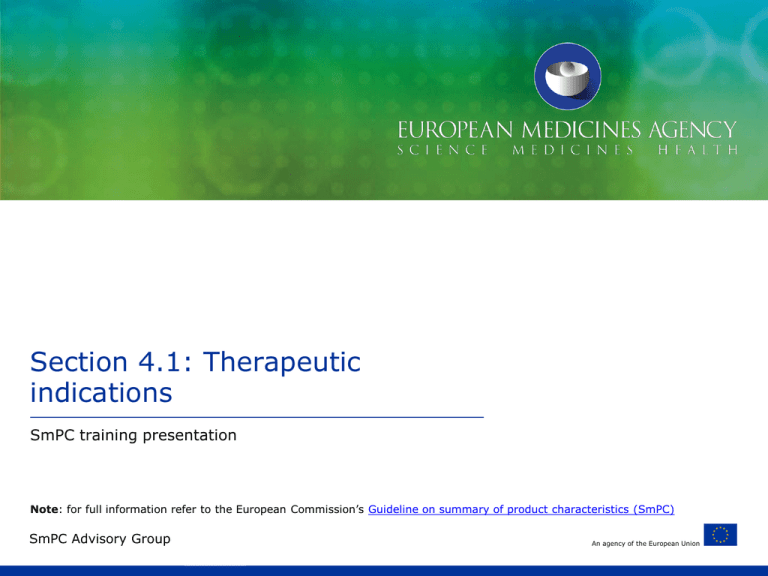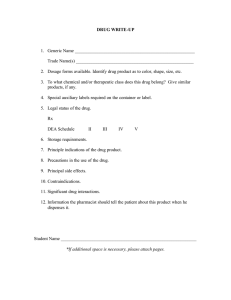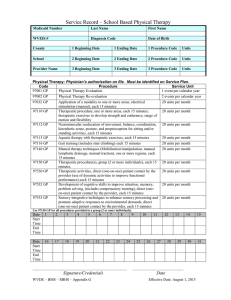Section 4.1: Therapeutic indications
advertisement

Section 4.1: Therapeutic indications SmPC training presentation Note: for full information refer to the European Commission’s Guideline on summary of product characteristics (SmPC) SmPC Advisory Group An agency of the European Union Index I. General objectives II. Key principles III. Additional information IV. FAQs 2 Section 4.1: Therapeutic indications I. General objectives of section 4.1 The section “Therapeutic indications” should clearly define the disease and the population for which the benefit risk balance of the medicine is positive Indication(s) should be stated clearly and concisely 3 Section 4.1: Therapeutic indications Section index II. Key principles Target disease or condition Treatment (symptomatic, curative, modifying) Prevention (primary, secondary) Diagnostic SmPC examples 1 symptomatic 2 curative 3 prevention 4 diagnosis Especially when restrictions to patient populations apply Target population Age groups, specifying age limits 4 X is indicated in <adults> <neonates> <infants> <Children><adolescents> <aged x to y <years, months> Section 4.1: Therapeutic indications 5 target population 6 age groups 7 age groups Section index Example 1–treatment – symptomatic Target disease or condition treatment (symptomatic) Active substance X 1.5 mg hard capsules Symptomatic treatment of mild to moderately severe Alzheimer’s dementia. Symptomatic treatment of mild to moderately severe dementia in patients with idiopathic Parkinson’s disease. 5 Section 4.1: Therapeutic indications Key principles Section index Example 2–treatment – curative Target disease or condition treatment (curative) Active substance X 1 g powder for concentrate for solution for infusion Active substance X is indicated in adults for the treatment of Clostridium difficile infections (CDI) also known as C. difficileassociated diarrhoea (CDAD) 6 Section 4.1: Therapeutic indications Key principles Section index Example 3–prevention Target disease or condition (prevention) Active substance X 40 mg hard capsules Active substance X 40 mg is indicated for the prevention of postoperative nausea and vomiting (PONV) in adults. 7 Section 4.1: Therapeutic indications Key principles Section index Example 4–diagnosis Target disease or condition (diagnosis) Active substance X 0.25 mmol/ml, solution for injection This medicinal product is for diagnostic use only. Contrast enhancement in magnetic resonance angiography (CEMRA). Active substance X is indicated for contrast-enhanced magnetic resonance angiography for visualisation of abdominal or limb vessels in patients with suspected or known vascular disease. 8 Section 4.1: Therapeutic indications Key principles Section index Example 5–target population Target population especially when restriction to patient population applies Active substance X 10 mg tablets Active substance X is indicated for the treatment of chronic hepatitis B in adults with: • compensated liver disease with evidence of active viral replication, persistently elevated serum alanine aminotransferase (ALT) levels and histological evidence of active liver inflammation and fibrosis; • decompensated liver disease. 9 Section 4.1: Therapeutic indications Key principles Section index Example 6–age groups Age groups, specifying age limits Active substance X 100 mg film-coated tablets Active substance X is indicated as adjunctive therapy in the treatment of seizure associated with Lennox Gastaut syndrome in patients 4 years and older. 10 Section 4.1: Therapeutic indications Key principles Section index Example 7–age groups Age groups, specifying age limits Active substance X powder and solvent for suspension for injection Active substance X is indicated for prevention of herpes zoster (“zoster” or shingles) and herpes zoster-related post-herpetic neuralgia (PHN). Active substance X is indicated for immunization of individuals 50 years of age or older. 11 Section 4.1: Therapeutic indications Key principles Section index III. Additional information Mandatory conditions of product usage SmPC examples 8 mandatory conditions 9 mandatory conditions Study endpoints should not normally be included unless recommended by CHMP Guidelines. Information on an authorised indication may be considered for inclusion in section 5.1 The objective of a prevention indication may be mentioned in general terms only 12 Section 4.1: Therapeutic indications 10 example CHMP Guidance Also see ‘Examples presentation’ for section 5.1 11 objective of prevention Section index Example 8–mandatory conditions Mandatory conditions of product usage not covered more appropriately in other parts of the SmPC may also be included when relevant. e.g. concomitant dietary measures, lifestyle changes, or other therapy Active substance X 120 mg hard capsules Active substance X is indicated in conjunction with a mildly hypocaloric diet for the treatment of obese patients with a body mass index (BMI) greater or equal to 30 kg/m², or overweight patients (BMI > 28 kg/m²) with associated risk factors. Treatment with active substance X should be discontinued after 12 weeks if patients have been unable to lose at least 5% of the body weight as measured at the start of therapy. 13 Section 4.1: Therapeutic indications Additional information Section index Example 9–mandatory conditions Mandatory conditions of product usage not covered more appropriately in other parts of the SmPC may also be included when relevant. e.g. concomitant dietary measures, lifestyle changes, or other therapy Active substance X 80 mg/ml oral solution Active substance X is indicated in combination with other antiretroviral agents for the treatment of HIV-1 infected patients (adults and children of 2 years of age and older). 14 Section 4.1: Therapeutic indications Additional information Section index Example 10–CHMP guideline Study endpoints should not normally be included, unless such mention is specified as being appropriate for the indication in the CHMP guidelines Where results from subsequent studies provide further definition or information on an authorised indication, such information, provided it does not itself constitute a new indication, may be considered for inclusion in section 5.1 Active substance X 2.5 mg tablets Section 4.1 Therapeutic indications Adults Active substance X is indicated for the treatment of schizophrenia. Active substance X is effective in maintaining the clinical improvement during continuation therapy in patients who have shown an initial treatment response. CHMP Note for guidance on the clinical investigation of medicinal products in the treatment of schizophrenia CHMP Note for Guidance on the clinical investigation of medicinal products in the treatment of schizophrenia 2.4 Recurrence/episodic symptoms and relapse. Relapse prevention studies may be used to show that the effect of medicinal products is maintained, but it is not an indication in itself. 15 Section 4.1: Therapeutic indications Additional information Section index Example 11–objective of prevention The objective of a prevention indication may be mentioned in general terms only Active substance X Primary Prevention Reduction of cardiovascular mortality and morbidity in patients with moderate or severe hypercholesterolemia and at high risk of a first cardiovascular event, as an adjunct to diet (see section 5.1) 16 Section 4.1: Therapeutic indications Additional information Section index IV. FAQs 1. What is the limit between a restriction of indication and a contraindication? 2. If data are missing to define a posology in a subpopulation e.g. infant, can the product be indicated in this population? 17 Section 4.1: Therapeutic indications Section index 1. What is the limit between a restriction of indication and a contraindication? • The SmPC guideline states that section 4.1 should define the target population especially when restrictions to the patient populations apply • A restriction to a patient population will be required when a positive benefit/risk balance has not been established in a subpopulation e.g. lack of data in a subset of the paediatric population • A medicinal product should be contraindicated in a situation where the medicinal product must not be given for safety reasons e.g. in patients with cardiac heart failure 18 Section 4.1: Therapeutic indications FAQs 2. If data are missing to define a posology in a subpopulation e.g. infant, can the product be indicated in this population? • A medicinal product can only be indicated in a subpopulation if a posology recommendation can be given. Therefore, if the benefit/risk assessment can not recommend a posology in a subpopulation, the indication should be restricted accordingly 19 Section 4.1: Therapeutic indications FAQs Thank you for consulting this training presentation SmPC Advisory Group Please note the presentation includes examples that may have been modified to best illustrate the related principle


